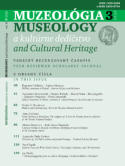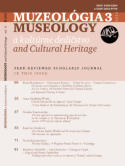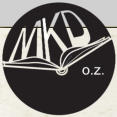

MUZEOLÓGIA
MUSEOLOGY
a kultúrne dedičstvo
and Cultural Heritage

News
New issue
Muzeológia a kultúrne
dedičstvo 1/2024
online New volume STUDIA MUSEOLOGICA SLOVACA vol. 7 (2023) online Populačné štúdie Slovenska (journal) onlineLast book
L. Jagošová a P. Tišliar (eds.). Slované - život a smrt v raném středověku. Materiály a statě. online
Contents 4/2023
Title: The Museum as a Laboratory of Change
Abstract: The article deals with the impact of temporary educational exhibitions in Polish national museums on the nature of the
knowledge they produce, protect and disseminate. Analysed data were collected during a year-long, qualitative research study with
the use of such tools as in-depth interviews, focus groups, research walks and desk analysis of documentation produced during the
creation of the Power of the Museum exhibition at the National Museum in Krakow. The primary research question is how the
museum’s ecology of knowledge (Rahder, 2020) reacts when the decision-making order is transformed and a new type of meta-
exhibition is built. The article aims to describe the mechanisms that stabilize museum knowledge traditions when the environment in
which they operate is changed internally and externally.
Author: Pisarek, Adam
Publication order reference: University of Silesia in Katowice, Institute of Culture Sciences, Faculty of Humanities, Poland, e-mail:
adam.pisarek@us.edu.pl, https://orcid.org/0000-0002-9872-364X
Source: Muzeológia a kultúrne dedičstvo, year: 2023, vol.: 11, number: 4, pages: 5-20.
Key words: museum’s ecology of knowledge, museum as a laboratory, temporary exhibitions
Language: English
online full-text PDF
DOI: 10.46284/mkd.2023.11.4.1
Title: War in European Museum Narratives and Cultural Memory
Abstract: The article examines how the war narrative is displayed in modern European museum exhibitions, particularly in light of
new museology and cultural memory trends in Germany and Poland. The study recognises that the contested nature of cultural and
historical contexts influences the process of representing cultural memory in museum narratives. It combines the theoretical approach
of museology with specific museum practices. Using case studies from the Bundeswehr Museum of Military History, Dresden,
Germany; the Documentation Centre for Displacement, Expulsion, Reconciliation, Berlin, Germany; and the Museum of the Second
World War, Gdansk, Poland, the author examines the impact of challenging issues centred on cultural memory of the war in museum
exhibitions over recent decades. The study underlines the significance of innovative approaches to museum exhibitions that display
the experience of war and contribute to social dialogue and sustainability.
Authors: Verbytska, Polina
Publication order reference: : Lviv Polytechnic National University, Institute of Humanities and Social Sciences, Department of
History, Museology and Cultural Heritage, 3 Mytropolyt Andrei Street, 79013 Lviv , Ukraine, e-mail: Polina.V.Verbytska@lpnu.ua,
https://orcid.org/0000-0003-3123-0768
Source: Muzeológia a kultúrne dedičstvo, year: 2023, vol.: 11, number: 4, pages: 21-43.
Keywords: war, museum narrative, permanent exhibition, cultural memory, forced migration
Language: English
online full-text PDF
DOI: 10.46284/mkd.2023.11.4.2
Title: The concept of small museums from an international and local perspective: starting points for
further research in the Czech Republic
Abstract: The study deals with the question, what is a small museum and what are its specifics compared to other museums. Based
on available foreign and local sources, it summarizes the current state of research which is largely focused on searching for the
consensus on how to clearly define this type of museums. The study is based on the published results of key research in the past
twenty years, it outlines selected approaches to the characteristics of a small museum and summarizes its typical features.
Analogously, it looks at the state of research in the Czech museum sphere, where the topic of small museums has been repeatedly
opened, examined and debated from different perspectives of professional activities and professions in a small museum. The study
raises the question of how to effectively build on this state of research and develop it further within the Czech Republic, where this
type of museums seems to be insufficiently mapped so far.
Author: Jagošová, Lucie
Publication order reference: Masaryk University, Faculty of Arts, Department of Archaeology and Museology, Arna Nováka 1, 602 00
Brno, Czech Republic, e-mail: jagosova@phil.muni.cz, https://orcid.org/0000-0002-3436-7404
Source: Muzeológia a kultúrne dedičstvo, year: 2023, vol.: 11, number: 4, pages: 45-58.
Keywords: small museum; micromuseum; museology; museum pedagogy; museum education; museum exhibitions
Language: English
online full-text PDF
DOI: 10.46284/mkd.2023.11.4.3
Title: Great Moravian jewellery and its presentation in exhibitions
Abstract: Ever since the first pieces of Great Moravian jewellery were found in early medieval burial grounds, which began to be
intensively and extensively explored mainly in Moravia after 1948, it was clear that these were not only elite goods related to the
highest social class in Great Moravia of that time, but also exhibition objects that bear the hallmark of exclusivity. Their artistic beauty,
the expensive material from which they were made, as well as the craftsmanship with which they were created, were and still are a
sure guarantee for the exhibitor that they will interest the public in some way. The paper focuses mainly on large exhibition events,
which from the 1960s presented Great Moravian jewellery not only to the Czech, but also to the foreign audience. At the same time, it
briefly outlines the future, which is connected with presentation of these exceptional archaeological finds, and which is in the hands of
the Moravian Museum in Brno.
Authors: Valášková, Lucie
Publication order reference: Moravian Museum, Centrum slovanské archeologie, Zelný trh 6, 659 37 Brno, Czech Republic, e-mail:
lvalaskova@mzm.cz, https://orcid.org/0000-0002-3076-5384
Source: Muzeológia a kultúrne dedičstvo, year: 2023, vol.: 11, number: 4, pages: 59-69.
Keywords: Great Moravian jewellery, elite goods, exhibition, Moravian Museum
Language: English
online full-text PDF
DOI: 10.46284/mkd.2023.11.4.4
Title: Preparation and realization of compact touring exhibitions on the example of exhibition
projects of the Masaryk University
Abstract: The article focuses on the specifics of the preparation and realization of compact touring exhibition projects. In the
introductory theoretical part, it deals with the issue of museum communication and museum presentation, their means, approaches
and forms, on the basis of which several types of exhibition projects are distinguished. Special attention is paid to touring exhibitions,
their specifics and possibilities in relation to the public. In the empirical part, the article contains several examples of the preparation
and realization of compact touring exhibition projects, implemented in the field of Museology at the Masaryk University in Brno.
Authors: Tišliar, Pavol
Publication order reference: Masaryk University, Faculty of Arts, Department of Archaeology and Museology, Arna Nováka 1, Brno
602 00, Czech Republic, e-mail: tisliar@phil.muni.cz, https://orcid.org/0000-0002-0886-7499
Source: Muzeológia a kultúrne dedičstvo, year: 2023, vol.: 11, number: 4, pages: 71-91.
Keywords: museum presentation, compact touring exhibitions, museum suitcase, student exhibitions, Masaryk University in Brno
Language: English
online full-text PDF
DOI: 10.46284/mkd.2023.11.4.5
Title: Exedrae as a tool of social visibility
Abstract: The article is focused on the public presentation of (not only) influential persons – the aristocracy, high-ranking citizens
(euergetes and benefactors) in ancient Greece in the period from the end of the 5th century BC to the 2nd century AD – through
structures known as exedrae. These architectural features, located on sites that are part of the cultural heritage, can still be found in
situ in the entire Eastern Mediterranean region. Presented will be case examples of exedrae and their connection to social
presentation as well as the issue of the primary purpose of their construction. In conclusion, two cases of these type of structures and
its fate will be mentioned in connection with its removal from the original findspot in effort to present it in a museum.
Authors: Molnárová, Miriam
Publication order reference: Masaryk University, Faculty of Arts, Department of Archaeology and Museology, Arna Nováka 1, 602 00
Brno, Czech Republic, e-mail: molnarova@phil.muni.cz, https://orcid.org/0000-0002-3653-0586
Source: Muzeológia a kultúrne dedičstvo, year: 2023, vol.: 11, number: 4, pages: 93-107.
Keywords: exedrae, scholae, social situation, euergetism, benefactorism, social visibility
Language: English
online full-text PDF
DOI: 10.46284/mkd.2023.11.4.6
Articles (Abstracts)

Full-text version
DOI:10.46284/mkd.2023.11.4.0
ISSN 1339-2204
eISSN 2453-9759
EV 1/22/EPP
Vol. 11 (2023), No. Is. 4




























